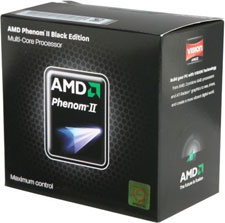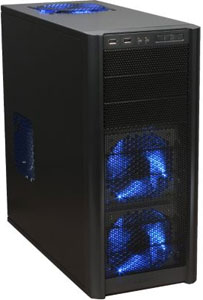Holiday 2010 System Builder's Guide
by AnandTech Staff, edited by Jarred Walton on November 19, 2010 2:00 AM EST- Posted in
- Guides
- Systems
- Holiday 2010
| Jarred's AMD Budget Gaming System | ||
| Hardware | Component | Price |
| Processor |
AMD Phenom II X4 965 Black Edition (Deneb 45nm, 3.4GHz, 4x512KB L2, 6MB L3, 125W) |
$166 |
| Motherboard | ASUS M4A88T-V EVO/USB3 (AMD 880G AM3) | $110 |
| Video | ASUS EAH6850 Radeon HD 6850 1GB | $200 |
| Memory |
A-DATA 2x2GB DDR3-1333 CL9 (AD3U1333B2G9-DRH) |
$62 |
| Hard Drive | Western Digital Caviar Black 640GB (WD6402AAEX) | $70 |
| Optical Drive | Samsung 22X DVDRW (TS-H662SA) | $15 |
| Case | Antec Three Hundred Illusion | $70 |
| Power Supply |
Antec BP550 Plus 550W (-$30 Combo) |
$35 |
| Total System Price | $728 | |
When it comes time to put together a PC for friends or family, price is usually a driving factor in every component selection. Depending on what compromises you're willing to make, you can easily get a complete system for under $500 (sans LCD, OS, and peripherals), but if I'm putting together a system I don't want compromises—I want a good PC that I'm confident will last at least three years, barring unforeseen component failures. So, my go-to system tends to focus on balancing price, quality, and performance, which means I check in right around the $500 mark. That's not bad for a PC, but what if you're interested in gaming?
Here's the thing so many people overlook when it comes to gaming consoles. The basic hardware will set you back $300 or less, but you end up occupying the living room, games cost more, and if you want to do things like surf the Internet, type a report, email, print, etc. you still have to have a PC somewhere in the house. So take your standard home/office PC, make sure you have a few upgrade options available (i.e. don't buy one of those ultra-budget systems with a tiny power supply, cramped chassis, and no PCIe x16 slot), and then you go out and buy a decent graphics card. Even the $115 graphics cards pack plenty of performance (i.e. the GeForce GTS 450), but for serious gaming you should plan on spending more like $200 and getting a GTX 460 or HD 6850. That's what I've done here, with a few other noteworthy extras.

First, notice the CPU: AMD's Phenom II X4 965 Black Edition. The stock 3.4GHz clock is already more than fast enough for any games, but the Black Edition means you can play around with overclocking without needing to raise bus or memory speeds. Sure, Intel has faster processors available, but for less than $200 it's going to be very difficult to match the performance of the Phenom II 965!
With an AMD CPU and motherboard chipset, $10 more gets you basic CrossFireX support—in this case courtesy of the ASUS M4A88T-V. You also get native SATA 6.0Gbps ports from the chipset and USB3.0 ports, so you've got just about everything you need to last you through the next two generations of hardware. And if games get to the point where a single 6850 can't handle your chosen resolution/settings, you can grab a second card and boost your performance! If you're serious about the CrossFireX route, though, you might want a motherboard with dual x8 PCIe slots as opposed to the x16/x4 on the selected ASUS board, in which case you're looking at another $20 to get something like the Gigabyte A-890GPA-UD3H.
As far as the GPU goes, the video card I selected is AMD's latest Radeon 6850, which is roughly on par with NVIDIA's GeForce GTX 460 1GB. Honestly, I would probably lean towards the latter on an Intel setup, but getting SLI support on an AMD platform is becoming rather difficult and pairing the AMD CPU with an AMD GPU has a nice symmetry to it. I'd suggest 1080p and high details as reasonable for the 460 and 6850, but you'll need to turn off antialiasing in some titles to get acceptable performance. The 6850 GPU I selected also comes from ASUS, by virtue of the fact that it was the quietest card in our 6850 roundup.

Some enthusiasts like to stay on the cutting edge, but that costs more money and the net difference often isn't worth the price of admission. I've been running an Intel Kentsfield processor at 3.2GHz for the past three years as my primary system (about the same performance as the Phenom II 965), and while I have a faster Core i7 desktop available I honestly don't notice the difference in most tasks. Gaming depends primarily on your GPU (unless you have a really slow CPU like Atom), so that's where you need to focus your money. You could even go with a cheaper CPU like the Athlon II X4 645 or the Phenom II X4 810, but as you can see from the linked results the overall performance drop likely isn't worth the money saved—especially if you want to upgrade to CrossFire down the road. Also worth noting is that there are games that hit the CPU quite hard (StarCraft II in large battles is particularly brutal), so don't skimp too much.
The rest of the components I've selected are still good in their own right, and there are plenty of sales and combo offers right now. If you have a bit of extra money left over, adding a moderate 64GB SSD as your OS/application drive is certainly worth doing, but with a focus on keeping costs down and gaming performance up, I left it out (and I'm sure others will include it). If you want an alternative to my selection, you could even go with the winning Newegg EggXpert PC SuperCombo (which has quite a few similarities to my build). Just add an OS, display, keyboard, and mouse and you're golden!










112 Comments
View All Comments
DanNeely - Friday, November 19, 2010 - link
I've always put my faith in the low score reviews than the high ones because people are morel likely to complain about bad parts than to write good reviews. You definitely do need to read the actual reviews and filter the idiots out first though.Brian Klug - Friday, November 19, 2010 - link
I'm glad someone caught me on the Xeon coolers - I usually forget that the boxed Xeons don't come with a cooling solution up until right as I start building, then run to the store and grab something.Honestly, everyone has their own LGA 1366/Socket B choice it seems. I went with one cooler one time that was too big for my Cosmos S case (the door wouldn't close), and hesitated to recommend something given that I haven't actually *seen* the SR-2 in the flesh. I wager one of those Zalmans that's flat (with the fan normal to the motherboard) probably makes most sense/has best chances of actually fitting.
Awesome comments ;) I wish I could build that thing, honestly!
-Brian
rootheday - Friday, November 19, 2010 - link
Interesting that the Intel budget system comes out >$120 higher than the AMD system... but most of that difference because of the choice to include a discrete GPU and BluRay drive in the Intel system. If you leveled that out (and chose same power supply/case) the Apples-to-apples comparison comes out much closer - down to a $40 difference (~10%).For that difference you get a tradeoff between slightly faster 3D graphics in the AMD 4250 (but neither will do much beyond casual gaming) vs Intel CPU that is faster in the case in most workloads and signficantly lower idle power. Both can handle media and normal browsing, photo editing, email, and productivity apps with ease.
JarredWalton - Friday, November 19, 2010 - link
Which is what we say at the bottom of the Intel page:"If you like comparisons, while some of the features are clearly different (i.e. Blu-ray, case, etc.), this Intel setup checks in at $40 more than our AMD build looking just at the motherboard and processor. It's true that Intel has plenty of less expensive processors, but rather than pitting Pentium G6950 against the Athlon II X4 645 we decided to go with the more capable i3-550. AMD's budget parts easily win in multi-threaded tests, but the Core 2010 architecture does very well in other areas. In other words, neither choice is always "right" but instead you need to decide what tasks are most important for your workload."
wwswimming - Friday, November 19, 2010 - link
This system is adequate for watching the Pipe Masters.Can I have it when you're done with it ?
Conficio - Friday, November 19, 2010 - link
I'm surprised with all the dream machines, that non of you went for one of the Multi Monitor setups.What is the hold back?
I'd think that is way more attractive for home use than a 24 GB 12 core XEON system, that is waisting more than half of its power and money going unused 95% of the time in any personal home use.
Really I'd like to hear why that does not seem to be on the wish list of any of you?
bji - Friday, November 19, 2010 - link
I can't see the point of multi monitor setups except when each monitor is used as a discrete desktop with no windows split across them. Setups where games split across monitors seem like the biggest joke to me. Who wants to play a game with a grid of bezels splashed across it? I can't believe that anyone even attempts such ridiculous setups or that these are featured by graphics card makers (AMD Eyefinity).Given that, I don't see too much point in multi-monitor setups for home use, when larger LCD panels (24 inches and above) give so much desktop real estate already.
geniekid - Friday, November 19, 2010 - link
1) I would love to see Brian's dream machine built and benchmarked.2) Does the MSI 890FXA-GD70 for Alan's HTPC support Dolby Digital Live/DTS Connect? If so, I assume the intention is to use SPDIF to send the digital audio to the receiver? Otherwise I'm surprised at the lack of a sound card.
3DoubleD - Friday, November 19, 2010 - link
To answer your 2nd question. Nearly every motherboard sold today supports DD and DTS over SPDIF. Even Windows Vista/7 drivers include support for this (along with 2ch LPCM support for other Windows sounds). So if a motherboard has SPDIF support (optical or coaxial), you have DD and DTS bit-streaming support guaranteed.ajlueke - Friday, November 19, 2010 - link
in response to 2). The idea as far as sound goes is to used the HDMI connection from the 5870 for sound. The AMD graphics cards have on board sound, as well as support for DTS-Master and TrueHD bitstreaming, no seperate soundcard required. I have found that multichannel support over the ATI cards for games is also very good, really makes Starcraft II come alive.